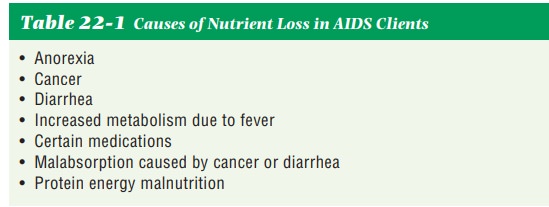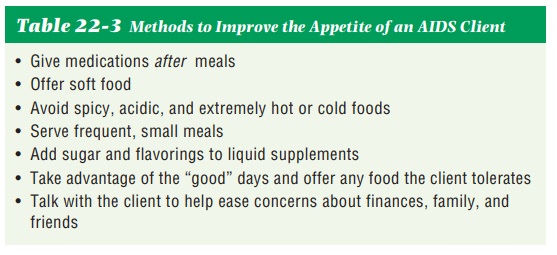Diet and Clients With Special Needs - Diet: Client with AIDS | Nutrition and Diet Therapy: Diet and Clients With Special Needs
Chapter: Nutrition and Diet Therapy: Diet and Clients With Special Needs
Diet: Client with AIDS
THE CLIENT WITH AIDS
A virus is a
microscopic parasite that invades and lives in or on, and thus infects, another
organism, called the host. The virus obtains nourishment from the host and
duplicates itself countless times. There are many viruses that infect humans.
Some, like those of the common cold, make the host only mildly ill. Others,
like the human immunodeficiency
virus (HIV), are deadly.
HIV invades the T
cells, which are white blood cells that protect the body from infections. When
the T cells cannot function normally, the body has no resistance to
opportunistic infections. Opportunistic
infections are caused by other microorganisms that are present but do not
affect people who have healthy immune systems.
Persons infected with
HIV are said to be HIV positive. HIV infection ulti-mately leads to acquired immune deficiency syndrome (AIDS), which is incurable
and fatal.
HIV can affect anyone
exposed to it, regardless of age, sex, or physical condition. HIV infection
cannot be cured, but it can be prevented. The virus is not transmitted through
casual contact, such as shaking hands. It is trans-mitted via body fluids,
specifically:
• Through sexual contact
• By transfusions of contaminated blood
• By use of contaminated needles during ear piercing, tattooing,
acupuncture, or injection of illegal drugs
• By infected mothers to their fetuses during pregnancy or to theirinfants during lactation
Progression from HIV Infection to AIDS
There are essentially
three stages in the progress of AIDS. The first stage begins soon after
exposure to HIV, when the body produces antibodies in an attempt to destroy the
virus. At that time, some people may experience a few days of symptoms
resem-bling mild flu. Others may have no symptoms. At this point and
thereafter, the infected person will test positive to HIV and will be among
those called HIV positive. Unless tested, the individual will feel normal and
will have no idea that he or she is HIV positive for a period ranging from a
few months to 10 years.
During this period,
the virus is incubating. Viral cells are multiplying in the tonsils, adenoid
glands, and spleen, gradually taking over the body’s T cells.
Anyone suspecting that
he or she has been exposed to HIV should be tested as soon as possible. An
ever-growing number of medications are avail-able that may increase the time
the virus needs to multiply and, thus, may prolong the life of the host.
The second stage of
HIV is known as the ARC period. ARC
stands for AIDS-related complex. The body’s immune system has by this point
grown weaker, and symptoms and opportunistic infections occur. There may be
fatigue, skin rashes, headache, night sweats, diarrhea, weight loss, oral
lesions or thrush (candidiasis, a fungal infection of the mouth), cough, sore
throat, fevers, or shortness of breath (Table 22-1).

The third and end
stage of HIV infection is known as AIDS (acquired immune deficiency syndrome).
It is manifested by a very low T-cell count, which makes it impossible for the
body to fight off infections. Tuberculosis or Kaposi’s
sarcoma commonly develops at this point. As the T-cell count continues
to diminish, other parasites invade and, ultimately, overwhelm the body,
causing death.
The Relationship of HIV Infection and Nutrition
A
healthful diet is essential for a healthy immune system, which may delay the
onset of AIDS. Persons diagnosed as being HIV positive should have a baseline
nutrition and diet assessment by a registered dietitian. Unhealthful eating
habits can be corrected at an early stage of the disease, and future
nutritional needs can be explained.
As the condition progresses, the client begins to experience the phys-ical problems previously listed. Infections increase the metabolic rate and nutrient and calorie needs and, at the same time, decrease the appetite and often the body’s ability to absorb nutrients.
Medications may further reduce the appetite
and cause nausea. When there are oral infections, taste may change, and
swallowing can become painful. Anorexia, or loss of appetite, commonly occurs
(Table 22-2). AIDS clients experience serious protein-energy malnutrition (PEM)
and, thus, body wasting. This may be referred to as HIV wasting syndrome, which
results in hypoalbuminemia and weight loss. The immune system is further
damaged by insufficient amounts of protein and calories, thus hastening death.

Problems Related to Feeding AIDS Clients
Just
when an AIDS client most needs a nutrient- and calorie-rich diet, he or she is
most apt to refuse it. In some cases, it may be useful to discuss nutritional
care with the client. When possible, medications should be given after meals to
reduce the chance of nausea. Sores in the mouth or esophagus can make eating
painful, and soft foods may be better tolerated than others. Taste can be
affected by the disease, so spicy, highly acidic, extremely hot, or extremely
cold foods may be rejected. Frequent small meals and, sometimes, liquid
supplements may be helpful. Additional sugar and flavoring may increase the
acceptability of liquid supplements. Because of the nausea and diarrhea, sufficient
fluids are essential. If the client has difficulty swallowing or simply cannot
eat, tube feeding may be imperative. If the tube causes pain or if severe
diarrhea or malabsorption is present, parenteral nutrition may be necessary.

The
client should be helped to eat as much as possible, especially on “good” days
(Table 22-3). Clients may suffer from pain and depression, and they may worry
about finances and what people think of them. These factors can further
diminish their appetites, but positive discussions can help.
Neurological
impairment usually occurs in varying degrees in AIDS clients and may cause
confusion and dysphagia. In such cases, meal trays should be kept simple, the
consistency of food modified to best suit the client, and special utensils
provided if needed.
Some clients may want to try nontraditional diets, thinking they will help or even cure them. These clients need to be made aware of any potentially harmful effects from such diets. In some cases, the idea of improvement may help the client’s appetite.
Those clients who will
benefit no further from either medication or nutri-tion can still be comforted
by the health care professional or hospice nurse who shows support,
understanding, and respect for them.
Related Topics